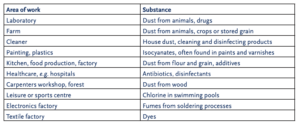Work-related lung conditions
The term, ‘work-related lung conditions’ refers to conditions that have been caused or made worse by the materials you come into contact with at work. This factsheet will look at some of the different types of work-related lung conditions, what can trigger them and how they can be dealt with.
There are many conditions that could be caused or aggravated by materials in the work place. Each one affects
the lungs in different ways and triggers different symptoms.
Work-related asthma
There are three different types of work-related asthma:
- Existing asthma that is made worse by the environment at work
- Asthma that can be caused for the first time by something in the work environment, such as a chemical or dust. It is estimated that this type of asthma may represent approximately 10% of asthma cases that begin in adulthood.
- A less common type is a condition known as reactive airways dysfunction syndrome (RADS), or acute irritant-induced asthma. This has the same symptoms as asthma, but is a long-term form of the condition which usually occurs from a single incident resulting in a sudden and large exposure to a material, such as a chemical spillage or fire.
What causes it? Many different substances can trigger work-related asthma. They are listed below:

Symptoms
People with work-related asthma experience the common asthma symptoms of coughing, wheezing, a tight chest and difficulty breathing. The substance can also affect the lining of the nose causing sneezing and a streaming or blocked nose; this is called rhinitis.
Treatments
The best way to treat the condition is to stop exposure to the material. This should be done as soon as the diagnosis is confirmed; ideally within a year of the onset of symptoms and that increases the chance of the asthma resolving. This may involve relocation within the same company or moving to a new job. If this is not possible, healthcare professionals can help with the management of symptoms within the workplace but this type of asthma can be difficult to control.
Allergic alveolitis
This condition is caused by an allergic reaction to an agent in the work environment that affects the alveoli (the small air sacs in the lungs). If a person is exposed for long periods of time, it can cause permanent scars.
What causes it?
The condition is caused by repeatedly inhaling tiny particles, which can cause an allergic reaction in some people. The most common occupational cause is currently from metal-working fluids, however many cases are also caused by moulds in grain or wood, or birds.
Symptoms
It can cause a tight chest and difficult breathing, which could happen within 12 hours of exposure. Unlike asthma, the condition is also associated with a fever. The severity of symptoms is usually related to the amount of exposure time. Weight loss is also common with continued exposure.
Treatments
As with work-related asthma, the best way to treat the condition is to stop exposure to the substance that is causing the reaction. This may mean improving ventilation in the work environment, or moving to another area in the workplace or changing to another job. Steroids can sometimes be given if the symptoms are severe and lung function is badly affected.
Work-related chronic obstructive pulmonary disease (COPD)
COPD is a condition caused by the weakening and narrowing of the airways. Most COPD is caused by smoking, however research suggests that approximately 15% of COPD cases are at least partially triggered by a certain material or agent in the work environment.
What causes it?
Possible causes of work-related COPD include:
- Dust from coal, cotton or grain
- A substance known as silica which is found in metal mines and pottery factories
- Second-hand smoke (passive smoking)
Symptoms
COPD causes damage to the lungs and difficulty breathing. Shortness of breath, cough and the production of small amounts of phlegm every day are common symptoms.
Treatments
As with smoking-related COPD, lung damage caused by occupational substances cannot be reversed even when the worker is no longer exposed to the cause. However, the symptoms of occupational COPD can be managed with inhaled drugs and exercise programmes.
Mesothelioma
Mesothelioma is a form of cancer. It is different to lung cancer as it affects the outside of the lungs, whereas lung cancer affects the lung tissue. Mesothelioma is caused by exposure to asbestos, a mineral that used to be commonly used in the construction of buildings. Lung cancer can also be a work-related disease, but it is usually caused after exposure to a much greater amount of asbestos than is needed to trigger mesothelioma.
What causes it?
Mesothelioma can be caused from just a short period of exposure to asbestos and usually occurs 15–50 years later. It commonly affects shipbuilders and breakers, builders, plumbers, electricians and painters but can affect anyone who has been in contact with asbestos. The European Union has now banned all use of asbestos.
Symptoms
The condition can cause pain in the chest wall, shortness of breath, wheezing and excessive tiredness.
Treatments
There is ongoing research to find new treatments for mesothelioma, as current treatments such as chemotherapy and radiotherapy are generally unsuccessful at curing the condition. Different therapies are offered to ease symptoms. The most common of these treatments is the removal of fluid from the chest to relieve breathlessness. The outlook for the disease is poor and by the time symptoms have developed, the disease is usually at an advanced stage.
Infectious diseases
A number of infectious lung diseases can be caused by materials in the work-place:
- Legionnaires disease spreads through air conditioning systems, putting hotel or leisure/sports centre workers at risk.
- Q Fever is caused by bacteria infecting farm animals, rodents or cats and dogs putting agricultural workers at risk.
What signs could indicate that you have a work-related lung disease?
There are different signs to be aware of for different diseases.
Asthma and allergic alveolitis: You may notice symptoms shortly after you’ve started a new job or work exposures have changed. If the symptoms improve when you are away from work (for example when you are on holiday) then further investigation is needed to see if the workplace is the cause. Rhinitis may start before the asthma, and symptoms in the nose may be an early warning sign of work-related asthma.
COPD and mesothelioma: These conditions have a much slower onset and usually develop after many years of exposure. If you know you’ve been exposed to materials that could cause these conditions, and you start to notice symptoms such as shortness of breath or persistent coughing, then this could be an indication of COPD or mesothelioma.
What should you do if you suspect a work-related condition?
If you have any lung symptoms that you suspect are caused, or made worse, by the work environment, it is important to mention this to your doctor or healthcare professional. If they suspect something at work is causing the problem, they will refer you to a specialist centre that focuses on occupational conditions. They will be able to provide you with an accurate diagnosis for your condition and identify whether the condition is linked to the work environment.
Once you have received a diagnosis and/or treatment for the condition, you will know whether you need to discuss with your employer how your work environment can be made safer for you, or whether you should consider moving to a different job.
Should you seek compensation?
If you have a condition that is proved to be caused by a problem in the work environment, you may think about seeking compensation. Your healthcare professional may be able to advise you on the best approach for this and how to speak to your employer.
The process for seeking compensation varies across Europe, so it is important to check what national policies are in place for your country concerning occupational illnesses. For example, there may be a national compensation scheme which is government funded, you may need to use your health insurance to make a claim, or you may be able to take legal action against your employer.
There is a lot of information about occupational conditions, particularly concerning asbestos, available on commercial sites hosted by law firms. It is best to be cautious about the information you receive on these sites and remember that this information should not be replaced by the advice you receive from a healthcare professional.
Action in Europe
The European Union (EU) has set the maximum amount of (air) concentration of a substance that can safely be allowed. Each Member State has also set their own limits, which often go further than those specified by the EU. You can read more about their recommendations on the website: http://ec.europa.eu/social
The European Agency for Safety and Health at Work (EU-OSHA) has included a list of different policies on their website: https://osha.europa.eu/en/topics
Further reading
- European Environment Agency: www.eea.europa.eu
- Healthy Workplaces initiative: www.healthy-workplaces.eu




